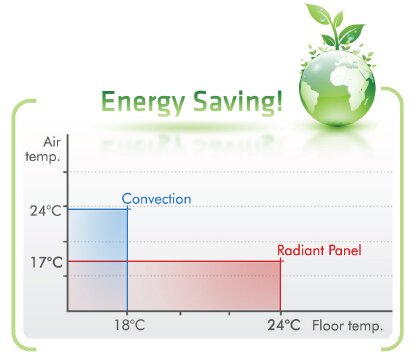How it works ?
EFFICIENT
COMFORTABLE
Radiant heating responds instantly to demand. There is no need to preheat a room. Simply switch on and you feel the warmth immediately.
MAXIMUM
… An even temperature all around the room:
The slim design and heating surface minimizes convection and maximizes efficient radiant heating.
… Cheaper than conventional comfort, for various reasons:
– Up to 75% of the energy used is converted in radiant rather than inefficient convected heat.
– No servicing or maintenance.
– Each room heated independently at the proper level with precise control.
– Possible to precisely match installed power to heating demand, creating the must efficient installation.
– The even surface temperature gives you better comfort.
– Studies have shown that with radiant heaters, it is possible to achieve comfort with air temperatures approximately 3°C lower than with conventional systems, meaning significant energy savings.

A REAL
Briefly explained, we can say that two tests were made:
– In the first phase, the walls are cold and the air is hot (up to 48°C!): the occupant feels cold.
– In the second phase, the walls are heated and the air is cold (10°C): the occupant feels warm.
Thus, it was determined that the temperature of the surrounding objects (radiation) is at least as important as the temperature of the air.
In the same way, you can feel the sun’s warmth in cold air. Air temperature is low, but radiant heat contribution is high.
The important factor is the exchange of energy on your skin which determines comfort. It is influenced by two factors : the temperature of the surrounding air and the level of radiation. The experience of the MIT shows that infra red RADIATION is a very important factor.
If there is significant air movement in the surrounding air, the skin surface will be cooled. This problem is avoided with Radiant Heating.
